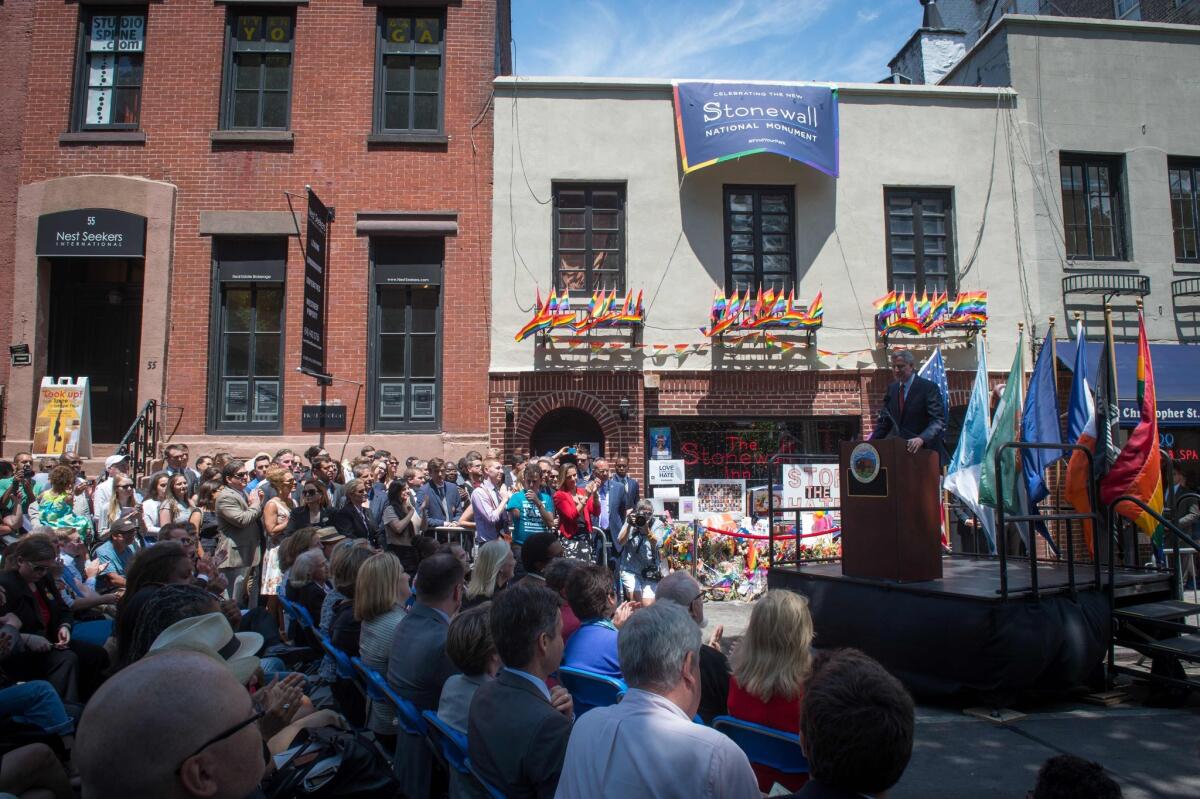The Stonewall Inn, the birthplace of LGBT movement, becomes a national monument

Reporting from New York â With dozens of tiny rainbow flags fluttering from the facade of the Stonewall Inn and dignitaries assembled on the street outside, Thomas Lanigan-Schmidt described the events of nearly half a century ago that led to this Greenwich Village bar on Monday becoming the first national monument dedicated to the struggle for LGBT rights.
On June 28, 1969, the New York artist was there when police officers broke down the door and charged inside what was then an illegal gay bar where patrons danced behind boarded-up windows.
Such raids were common. âWe grew up in an era when everything was totally repressed,â Lanigan-Schmidt said. âLiberals thought we should be thrown in mental asylums and conservatives thought we should be thrown in jail.â
But the police vans that were usually on hand to take rounded-up patrons to precinct houses arrived late that night, giving a crowd time to form. The police were outnumbered. A riot ensued and lasted several days.
âWe fought back because we were humanized in there,â Lanigan-Schmidt said. âNowhere else could we dance slow. That night everything changed.â
The Stonewall riots were the flashpoint that launched the gay rights movement.
The Stonewall National Monument was designated as such by President Obama last week and officially dedicated Monday. Overseen by the National Park Service, it includes the Stonewall Inn, a small park and some nearby streets.
âToday we welcome Stonewall and Christopher Park into the family of the Grand Canyon, Yosemite and the Statue of Liberty, Americaâs most important places,â John Jarvis, director of the park service, told a cheering crowd. âThis story is a key component of the American experience.â
Speaker after speaker emphasized the importance of having a national monument dedicated to Stonewall and the struggles of gay, lesbian, bisexual and transgender citizens.
âItâs a sacred place where we honor those like Tommy [Lanigan-Schmidt] who bravely stood up and spoke out so others werenât compelled to live in silence,â said Sen. Tammy Baldwin (D-Wisc.), the first openly gay U.S. senator.
The inn has long been a powerful symbol of the LGBT rights movement.
It was a place people gathered to celebrate last yearâs U.S. Supreme Court ruling upholding same-sex marriage, and to mourn the mass killings at Orlandoâs Pulse gay night club this month.
The streets around the bar are usually jammed during New Yorkâs massive gay pride parades, including the march held one day before the dedication.
Jennifer Richards, a 35-year-old teacher, said she first heard about Stonewall when she was about 14 and âbeginning to know myself.â In her 20s, she went inside â her first gay bar.
Its elevation to a national monument âmeans recognition and getting our stories out there to a wider audience,â said Richards, who drove from her home in upstate New York to attend the dedication.
The celebration was tempered by the killings in Orlando, as several participants said more needed to be done to secure full equality for the community.
âWe would have celebrated what is good about today and remembered the pain of the past either way, but Orlando put things into a sharper perspective,â Mayor Bill de Blasio said. âThis is not a place where change happened easily or calmly or gently. It came through a fight. It came through a struggle and that fight must now continue.â
Spectators echoed those emotions. âI feel joyous, sad and hopeful, a melting pot of emotions,â said 26-year-old Gabrielle Silverstein-Tapp, who made the short trip from Brooklyn. âThis is so incredibly moving, but there is so much more that needs to be done.â
Haller is a special correspondent.
More to Read
Sign up for Essential California
The most important California stories and recommendations in your inbox every morning.
You may occasionally receive promotional content from the Los Angeles Times.









